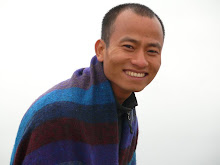During a six-hour interview in this border town, the monk, Ashin Kovida, said he had been elected the leader of a group of 15 of his fellows and led daily protests in Yangon from Sept. 18 through Sept. 27, the day after the authorities began raiding monasteries.
He said he was inspired by the popular uprisings in Yugoslavia against the government of Slobodan Milosevic, videos of which were circulated by dissident groups in Myanmar.
Eight members of his organizing committee are “missing” and six others are hiding in Yangon, he said. He described escaping to Thailand by using a false identification card, dyeing his hair blond and wearing a crucifix.
Many details of Mr. Kovida’s account could not be independently confirmed, but his role as an organizer was well known among nongovernmental organizations in Myanmar, formerly Burma, and Western human rights groups.
Hlaing Moe Than, 37, a leading organizer of students in the September demonstrations who also fled to Thailand, was shown a picture of Mr. Kovida on Thursday and confirmed his identity.
“He is one of the famous leaders among the Buddhist monks during the protests,” Hlaing Moe Than said.
Mr. Kovida’s group received financial help from three well-known Burmese dissidents — an actor, a comedian and a poet — but it did not receive foreign aid during the protests, he said.
One of his main preoccupations, he said, was providing food for the thousands of monks who came to Yangon, Myanmar’s main city, to join the protests. He said he also worried about what he called “fake monks,” whom he suspected the military government had planted.
The spark for the demonstrations came on Sept. 5, when the police fired warning shots at protesting monks in Pakokku, in central Myanmar, Mr. Kovida said.
“The first time I heard the information, I was speechless,” he said. “It was an unbelievable thing.”
Older monks and abbots urged the monks to protest in the monasteries, but the younger monks thought protesting in their cloistered world would do no good, he said.
He reached out to students he had met during alms collections and began to plan marches in Yangon.
“We realized that there was no leadership — a train must have a locomotive,” he said.
He said he helped supervise the printing of hundreds of pamphlets, titled, “The Monks Will Come Out Onto the Streets.”
“We delivered to all the monasteries.” in Yangon, he said. “We tried to distribute to other regions as much as possible.”
On Sept. 18, he led the first column of monks through the streets in Yangon, he said.
On Sept. 19, about 2,000 protesters, including 500 monks, sat on the tiled floor in Sule Pagoda, a focal point of the protests. “To continue demonstrations in a peaceful way we must have leadership,” Mr. Kovida said he told them. “I call on 10 monks to come join me in the front.”
Fifteen monks came forward, he said, to form what they called the Sangga Kosahlal Apahwe, the Monks Representative Group.
“In this country at present we are facing hardships,” he said he told the crowd, after he was elected chairman of the group. “People are starving; prices are rising. Under this military government there are so many human rights abuses. I call on people to come to join together with us. We will continue these protests peacefully every day until we win. If there are no human rights, there is no value of a human.”
He said that, for a week, he met with his group of organizers in the morning and led marches at noon. He said he heard reports on the Burmese-language service of the BBC about other monks who had organized themselves but he had never met them.
Then, on Sept. 26, the government began a violent crackdown. Security forces clubbed and tear-gassed protesters, blocked their path and arrested hundreds.
“The police pulled the monks’ robes and beat them,” Mr. Kovida said. “Nuns were stripped of their sarongs.”
He said he escaped by climbing over a brick wall.
The next day, as the crackdown intensified, he said he changed out of his robes and fled to a village about 40 miles away where, with the help of relatives and friends, he hid in an abandoned wooden hut.
He was so afraid of attracting the attention of neighbors that he suppressed his coughs and never left the dark hut for two weeks, he said. He relieved himself using a plastic bucket, he said, and friends occasionally dropped off food.
On Oct. 12, his adoptive mother, whom he called Daw Thin Thin Khaing, was detained, news that was immediately relayed to him. He fled into the night, barefoot.
“I ran down a large road,” he said. “Whenever a car came I hid in the bushes.”
He headed back to Yangon, he said, where he dyed his hair blond. He bought a crucifix in a local market and, several days later, boarded a bus heading toward the Thai border.
Using a false identity card, he passed about eight checkpoints and reached Myawadi, a border town, on Oct. 17. The next morning, he said, he crossed the Moei River to Thailand in a boat, bypassing the official border post.
An Oct. 18 article in The New Light of Myanmar, the state-run newspaper, accused him of hiding “48 yellowish high-explosive TNT cartridges” in his monastery.
Now, facing almost certain detention in Myanmar, Mr. Kovida said he would request refugee status in Thailand.
“I have been in the monkhood since I was so young,” he said. “My whole life, I have been studying only Buddhism and peaceful things.”
















0 comments